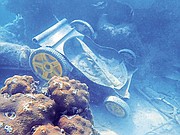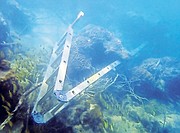PATCHES of coral reef the size of a car were ripped out by Hurricane Dorian when it tore through the northern Bahamas, according to an assessment by experts. The Perry Institute for Marine Science (PIMS) reported the results of its survey, conducted from October 8 to 22, on Wednesday.
They said the storm ripped out large chunks of coral reef, leaving them scattered like bowling pins. The storm also dragged mud from the shoreline and dumped it onto reefs, burying them in silt more than two feet deep.
Casuarinas were also thrown into the sea by ferocious winds, damaging corals and crushing other underwater sea life. A statement from PIMS warned that some reefs will take decades to recover, if at all.
There was good news as well, however. The statement said: “These (damaged) places, however, are in the minority - good news for thousands of Bahamians who make their living from this critical economic driver, the turquoise waters of the ocean surrounding The Bahamas. Most coral reef sites throughout Grand Bahama and Abaco are in pretty good shape.”
The survey was conducted by PIMS along with partners from The Nature Conservancy, Middlebury College, the Angari Foundation and others.
“Some reefs look totally different now than they did before. Still, it’s really a mixed bag. Some places I thought were going to be totally destroyed came out looking fine and other places that were really not hit that bad by wind and storm surge have reefs covered with silt and the corals are being smothered,” said Dr Craig Dahlgren, a marine ecologist and PIMS executive director who studies a wide range of topics related to tropical marine ecosystems.
“It’s going to take a while for us to fully understand why things happened the way they did. I think we’re going to have to go back and do more in depth studies on some of these areas to see how they might naturally recover and what we can do to help them recover. In some cases, the reefs have been fundamentally changed from what they were before.”
Underwater, debris from the land ranging from trees to metal roofs to construction materials and household contents littered the ocean floor. Observers also noted broken corals, reef structure collapse, reduced fish populations and some coral bleaching off North Abaco. It was unclear if the bleaching was as a result of the storm or due to elevated temperatures.
“There have been a lot of other studies on coral reefs hit by hurricanes but nothing with such a good, timely data set going into the storm over such a large area. Then, to get back so quickly after the storm hit and to be able to assess so many of these places which were impacted by the storm differently, we are really able to see what the storm did and have a really good before and after picture for this one,” said Dr Dahlgren who from June 2018 to July 2019 led a team of researchers conducting extensive assessments of the health of reefs in Abaco and Grand Bahama.
Dr Krista Sherman, senior scientist at PIMs, said there was a silver lining. “On a positive note, all the coral nurseries survived, and out planted corals appear to be doing well,” she said.
Additional, reef sites surveyed within several marine protected areas, including Peterson Cay National Park, Lucayan National Park, Pelican Cays National Park, Fowl Cays National Park and Walker’s Cay National Park sustained minor storm damage.
The expedition was funded by the Devereux Ocean Foundation, Disney Conservation Fund, Atlantis Blue Project Foundation, the Angari Foundation and the R/V Angari.






Comments
Use the comment form below to begin a discussion about this content.
Sign in to comment
Or login with:
OpenID